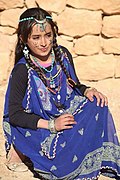Top Qs
Timeline
Chat
Perspective
Chaoui people
Berber ethnic group in northeast Algeria From Wikipedia, the free encyclopedia
Remove ads
The Chaoui people or Shawyia (Arabic: الشاوية, Tachawit: Išawiyen) are a Berber ethnic group native to the Aurès region in northeastern Algeria.[2]
This article has multiple issues. Please help improve it or discuss these issues on the talk page. (Learn how and when to remove these messages)
|
They call themselves Išawiyen/Icawiyen (pronounced [iʃawijən]) and speak the Shawiya language. They are the second largest Tell Atlas Berber-speaking ethnicity, alongside the Kabyles and Chenouas.[citation needed]
Remove ads
Etymology
According to de Slane, translator of the books of Ibn Khaldun, the term Chaoui/Shawi means "shepherd" and designates the Zenata Berbers.[3]
History
Historically, the Aurès Mountains served as a refuge for Berber peoples, forming a base of resistance against the Roman Empire, the Vandals, the Byzantine Empire and Arabs.[citation needed]

The patriarch of Berbers is believed to have been Madghacen, the common ancestor of the Zenata and of the Botri as well. Ibn Khaldun identified the Zenata as Berbers. Modern historians rank this Berber region within the group of Numidians and Gaetuli or the much more ancient Meshwesh, Maesulians and Mazaxes, from whom the Zenata formed, the main inhabitants of the Aurès in the Middle Ages. Chaoui clans known by Ibn Khaldoun were the Ifren, Maghrawa, Djerawa, Abdalwadides, Howara and Awarba.[citation needed]
After the independence of Algeria, the Chaouis remained localized mainly in the Auresian region. They are the second largest Berber-speaking group in terms of number of speakers, the first being the Kabyle.[citation needed]
Remove ads
Language

The Chaoui traditionally speak the Shawiya language (Berber: Tachawit). It belongs to the Berber branch of the Afro-Asiatic family, and is a variety of the Zenati languages. Shawiya is a closely related cluster of dialects spoken in the Aurès region (Berber: Awras) of eastern Algeria and surrounding areas including Batna, Khenchela, south Sétif, Oum El Bouaghi, Souk Ahras, Tébessa, and the north part of Biskra. Recently the Shawiya language, together with the Kabyle language, has begun to achieve some cultural prominence due to the Berber cultural and political movements in Algeria.[citation needed]
Culture and art
Chaoui music is a specific style of Berber music. The Shawia dance is called Rahaba; men and women dancing at weddings. There are many 20th century singers, such as Aïssa Djermouni, Ali Khencheli, Massinissa, Ishem Boumaraf, Djamel Sabri, Groupe Iwal, Houria Aïchi, etc.[citation needed]
Chaoui painters and sculptors (of whom there are many) include Cherif Merzouki, Abdelkhader Houamel, Hassane Amraoui, Adel Abdessemed, and Mohamed Demagh.[citation needed]
The fantasia is a traditional exhibition of horsemanship in the Aurès performed during cultural festivals.[citation needed]
The Chaoui were featured in Amor Hakkar's 2008 film La Maison jaune.
Examples of Chaoui craftwork
- Bendir with snares.
- Chaoui jewelry, Museum of Man, Paris, during an exhibition Germaine Tillion.
- Chaoui bread.
- A woman wearing traditional chaoui dress.
- An Algerian girl wearing traditional chaoui dress.
Remove ads
References
Bibliography
External links
Wikiwand - on
Seamless Wikipedia browsing. On steroids.
Remove ads






